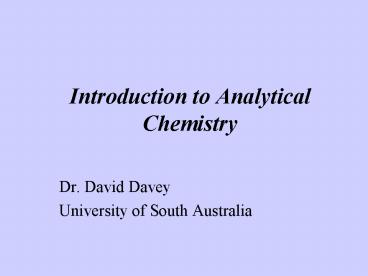Introduction to Analytical Chemistry - PowerPoint PPT Presentation
1 / 11
Title:
Introduction to Analytical Chemistry
Description:
as herbicides ? Test for presence of As in grass. Test for ... Supports the Contention that herbicide caused death. Introduction to Analytical Chemistry ... – PowerPoint PPT presentation
Number of Views:211
Avg rating:3.0/5.0
Title: Introduction to Analytical Chemistry
1
Introduction to Analytical Chemistry
- Dr. David Davey
- University of South Australia
2
Introduction to Analytical Chemistry Semester 2
3
Introduction to Analytical Chemistry Semester 2
Practical Work
- Classical methods
Sampling Standards Simple equipment Manipulative
skills Colour appreciation
- Instrumental methods
Complex equipment for final measurement
4
Introduction to Analytical Chemistry Some Basic
Questions
- Have Chemical Instruments improved in recent
years ? - Do Chemists provide meaningful answers to
problems ? - Are Chemists providing answers with better
accuracy and precision compared to 60 years ago ?
5
Introduction to Analytical ChemistryYes. There
has been A Revolution in Analytical
Instrumentation
- New Instruments
- Computing power and improved quality of
information through computing - More detailed analyses can be done
- Detection of ultratrace amounts
- Faster methods of sample preparation
- microwave ultrasonics
6
Introduction to Analytical ChemistryA
Revolution in Analysis continued
More detailed analyses Separation Methods
GC HPLC Detection of ultratrace amounts New
SensorsNew Instruments Optical Devices UV vis,
FTIR
7
Introduction to Analytical Chemistry
- Do Chemists provide meaningful answers to
problems ? - Are Chemists providing answers with better
accuracy and precision compared to 60 years ago ? - These questions bring us to examine the
Analytical Method
8
Introduction to Analytical Chemistry The
Analytical Method
- Define the Problem
- Obtain and Prepare the sample
- Select a method of measurement
- Data acquisition and treatment
- Assess the quality of results
- Report the solution in terms
- relevant to the problem
9
Introduction to Analytical Chemistry The
Analytical Method contd
- Obtain a representative sample
- Preparing the laboratory sample
- Define replicates
- Dissolve samples
- Adjust sample for method
- Define the Problem
- Select a Method
- Calibrate the Method
- Eliminate Interferences
- Measure the samples
- Calculate Results
- Estimate the precision
- Report the solution to the problem
10
Introduction to Analytical Chemistry The
Analytical Method - Study in Toxicology
- Did a Herbicide kill a Deer ?
- Possible use of Arsenic Compounds
- as herbicides ?
- Test for presence of As in grass
- Test for presence of As in Deer organs
- Measure levels of As in grass
- Measure levels of As in Deer organs
11
Introduction to Analytical Chemistry Study in
Toxicology continued
- Select a Method
- As in biological samples ?
- Examine a Method and make sure workable
- Form AsH3
- Arsine is volatile (an advantage as we will see)
- Select a sample
- Obtain a representative sample, kidneys
- Grind the selected samples finely
- Other deer samples
12
Introduction to Analytical Chemistry - Study in
Toxicology continued
- Prepare a sample
- Dry and ash the sample giving H3AsO4
- H3AsO4 is reduced to H3AsO3
- Eliminate Interferences
- Form AsH3 which is volatile
- The gas is separated from solution and other
elements - It forms a red coloured complex with
dithiocarbamate
13
Introduction to Analytical Chemistry - Study in
Toxicology continued
- Analytical Results
- Grass 600 ppm
- Two deer
- 16 and 22 ppm
- As toxic above 10 ppm - Literature
- Conclusion
- Chemical Analysis indicates a Toxic Level of As
present in the Deer - Supports the Contention that herbicide caused
death
14
Introduction to Analytical Chemistry Are
Chemists providing answers with better accuracy
and precision compared to years ago ?
The Analysis of Complex Materials
- New Instruments are not the complete solution
- The accuracy of analysis is dependent on the
nature and complexity of the material - Errors of 1-2 are excellent
- Errors of 5-10 are common
- Higher errors observed for trace amounts
15
Introduction to Analytical Chemistry The
Analysis of Complex Materials
- Precision for most Analyses has not improved over
the years due to- - neglect of sample preparation, and
- poor knowledge of chemical interferences
Precision sd
Year
16
Introduction to Analytical Chemistry Some
Conclusions
- Better Instruments are available
- The Analyst must solve the problem presented
- Method Selection and Sample Preparation are key
- Chemical Interferences must be considered
- Difficult Samples still give poor results































